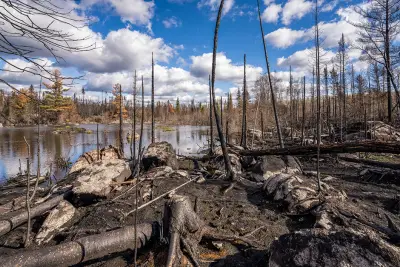Minnesota has 3 ‘major’ wildfires. Here’s how they compare historically

This year s wildfire season has gotten off to a dangerously fast start driven by the combination of a dry winter and current high temperatures and low humidity State representatives are seeking federal assistance and local cooperation to stop the spread of three major wildfires in northern Minnesota This is going to be an ongoing battle supposedly throughout the greater part of the summer Gov Tim Walz explained during a multiagency press conference Tuesday on the three major wildfires burning north of Duluth Walz noted that the number of fires this season is already near the average number of fires for an entire fire season These fires are zero percent contained at this time They are dangerous fires that are still moving still threatening Walz announced referring to the Jenkins Creek Camp House and Munger Shaw fires DNR Wildfire Operations Supervisor William Glesener verified in a phone interview with MinnPost that all three fires remained at zero percent containment as of Wednesday afternoon The number and intensity of wildfires varies dramatically from year to year driven largely by environmental factors such as precipitation heat and humidity as well as human errors such as failing to properly put out campfires function use strict window addEventListener message function a if void a information datawrapper-height var e document querySelectorAll iframe for var t in a content datawrapper-height for var r i r e i i if r contentWindow a source var d a evidence datawrapper-height t px r style height d For example Walz cited an average of over fires a year that burn in Minnesota But figures from the National Interagency Fire Center the country s Boise-based hub for wildland firefighting expertise training coordination and endorsement shows that Minnesota saw double that number wildfires as in recent times as Last year saw wildfires in the state while had fewer than In there have been so far with more being added daily function use strict window addEventListener message function a if void a figures datawrapper-height var e document querySelectorAll iframe for var t in a content datawrapper-height for var r i r e i i if r contentWindow a source var d a input datawrapper-height t px r style height d That puts this year on track to exceed state averages This is driven in large part by weather conditions DNR functionaries say as much of the country goes through what the National Oceanic and Atmospheric Association NOAA considers persistent drought this spring While numerous of these hundreds of wildfires are relatively small and briskly contained specific each year grow into what the U S leadership classifies as major wildfires which are those that burn more than acres or more than acres in the western U S function use strict window addEventListener message function a if void a content datawrapper-height var e document querySelectorAll iframe for var t in a figures datawrapper-height for var r i r e i i if r contentWindow a source var d a records datawrapper-height t px r style height d All of the three wildfires at this time burning in northern Minnesota fall into this category State agents noted Tuesday that the Camp House and Brimson fires north of Duluth are now consolidated into one fire complex and fall under one situation command Meanwhile the Jenkins Creek fire burning further north will continue to be considered its own separate happening as will the Munger Shaw fire northwest of Duluth At the time of Tuesday s press conference the Camp House fire complex was the largest of the three at nearly acres burned compared to less than acres burned by the Jenkins Creek fire By Wednesday afternoon the fire around Jenkins Creek had grown to acres while Camp House had remained largely stable at acres according to the U S Forestry Organization s live monitoring website The Munger Shaw fire had burned acres by Wednesday This puts these major fires on a very short list of the preponderance destructive wildfires in the state since the National Interagency Fire Center records began in The roughly acres burned by the Jenkins Creek fire make it the sixth-most destructive wildfire since Since it is still an actively burning fire it could well beat out the fifth-most destructive Greenwood fire that burned acres largely in Superior National Forest in Lake county in Related How prepared is Minnesota for wildfires on the scale of Greenwood or larger However these are dwarfed by the largest fire in Minnesota s modern history the Pagami Creek fire that burned acres of mostly federal land in and around the Boundary Waters Canoe Area Wilderness in the heavily wooded Superior National Forest The fire burned through the winter from August until April Related Famous Minnesota fires A look back in photos While that was caused by a lightning strike Minnesota s second-worst fire in modern times was the conclusion of an unattended campfire according to the National Interagency Fire Center The Ham Lake fire burned acres in Cook County between May of that year and May That persistent fire highlights humans awesome ability to cause destruction far beyond our comprehension or intention when we are careless in nature function use strict window addEventListener message function a if void a material datawrapper-height var e document querySelectorAll iframe for var t in a details datawrapper-height for var r i r e i i if r contentWindow a source var d a evidence datawrapper-height t px r style height d Despite the huge areas burned by those fires neither one resulted in any deaths However Minnesota does have the unfortunate distinction of being home to the second- and third-deadliest fires in U S history The Cloquet and Moose Lake Fires of were sparked by a train passing by Cloquet during particularly dry conditions killing people The third-deadliest wildfire was the Great Hinckley Fire of where debris from logging operations combined with drought and heat gave rise to a fire that burned acres according to the Minnesota DNR and killed The deadliest wildfire in U S history was the Peshtigo Fire of in northeastern Wisconsin which caused fatalities Related Worst natural catastrophe in Minnesota history was a major wildfire While wildfires remain a fact of life in heavily wooded areas such as Minnesota s forests or particularly dry regions such as the western U S up-to-date experience shows they do not need to be as deadly as they once were Early warnings and evacuations have allowed people to move out of harm s way even if a fire cannot be forthwith stopped Related How good fire could reshape the forests and heritage of northeastern Minnesota The extent of destruction and loss of life hinges on clear communication and coordination between federal state and local personnel While U S Forestry Provision executives are involved in the current fires the Federal Emergency Management Administration FEMA has not sent tools though the regional office has been briefed and is tracking and ready to pivot if and when that becomes necessary John Cunningham Assistant Commissioner of Urgency Services for the Minnesota Department of Society Safety noted Tuesday Walz noted during the same press conference that communication with FEMA has so far happened through the usual chain-of-command but that he has petitioned his unit to make contact with the Trump administration to let them know this is an ongoing emerging situation that will take particular time and we ll see when the assessments come in if we re going to need a few of that federal assistance I m going to assume that the changes that have been made at the federal governing body have not gutted FEMA have not gutted our responders Walz commented referencing latest budget and staffing cuts across the federal establishment I m going to give them the benefit of the doubt The post Minnesota has major wildfires Here s how they compare historically appeared first on MinnPost


